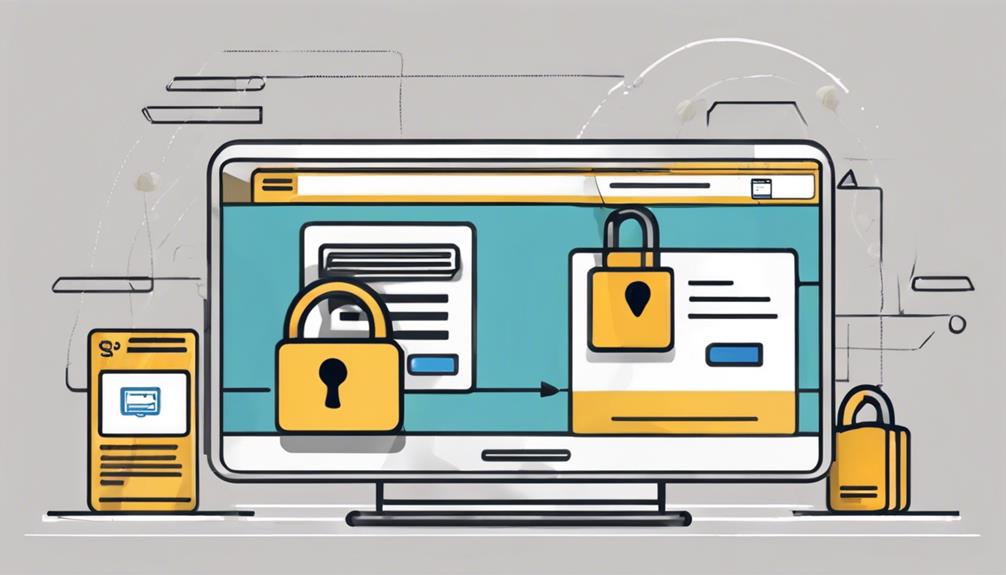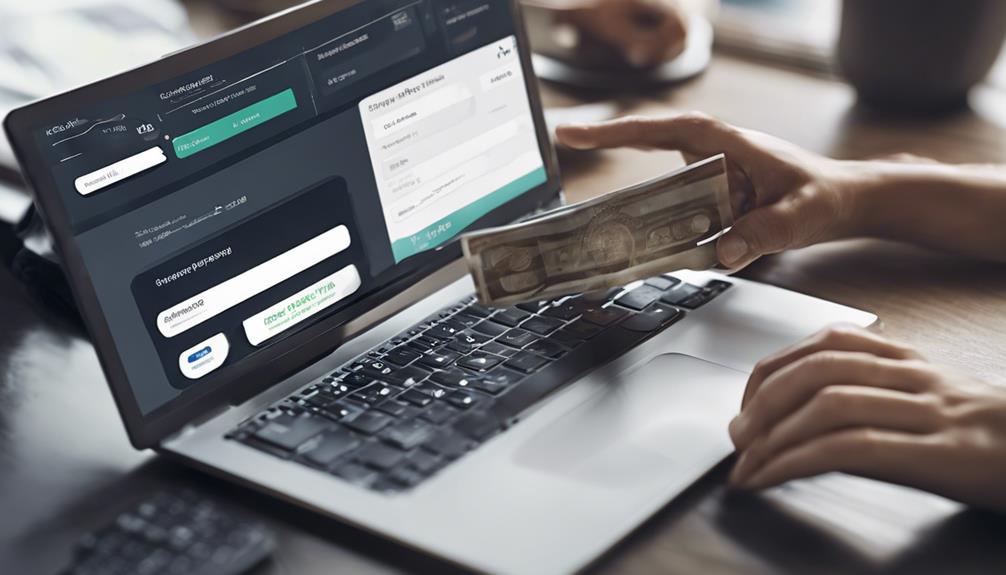When processing payments for digital products, we follow a detailed process involving five key steps to ensure seamless and secure transactions. First, customers select their products and proceed to the checkout, confirming their payment information is accurate. Next, we use a secure payment gateway with encryption and fraud prevention measures to build trust and protect customer data. Then, authorization and verification procedures are implemented to validate payment details and utilize secure protocols to prevent fraud.
Funds transfer and confirmation involve electronic transactions and payment processor roles, granting immediate access to purchased digital content. Finally, notifications and goods delivery ensure timely updates and access details notifications via automated systems, enhancing the overall customer experience. Learn more about optimizing digital goods payment processing for efficiency and security.
Key Takeaways
- Customer Selection and Checkout process is crucial for adding digital goods to cart.
- Secure Payment Gateway with encryption and fraud prevention ensures customer data safety.
- Authorization and Verification steps ensure successful and valid digital goods transactions.
- Funds Transfer involves electronic transactions for immediate access to purchased digital content.
- Notifications play a key role in timely delivery of purchased digital goods for enhanced customer experience.
Customer Selection and Checkout
When we shop for digital goods online, our first step is selecting the items we want and adding them to our cart. This process involves carefully choosing the digital products or services that meet our needs. Once we've finalized our selection, we proceed to the checkout process.
During checkout, we're required to provide our payment information, which can include credit card details, digital wallets, or even opt for online bank transfers. Additionally, entering our contact information ensures that we receive essential updates and notifications regarding our purchase.
The checkout process is crucial as it marks the point where we verify our order details and proceed with the payment completion. It's essential to double-check the accuracy of the entered information to prevent any delays or errors in the transaction. After the successful payment completion, instant delivery of the digital goods is a common practice in online transactions. This efficient process ensures that we promptly receive access to the purchased digital goods, enhancing our overall shopping experience.
Secure Payment Gateway Processing

To ensure the safety and confidentiality of online transactions for digital goods, utilizing secure payment gateways is paramount. When processing payments through a payment gateway, the security of customer data and financial transactions is a top priority. Here are five key points to consider:
- Encryption: Secure payment gateways encrypt customer data, providing a secure layer of protection for sensitive information.
- Fraud Prevention: They offer protection against fraudulent activities, ensuring the safeguarding of payment details.
- Advanced Security Features: Leading payment gateways like Stripe and PayPal utilize advanced security measures such as tokenization and SSL encryption to enhance transaction security.
- Building Trust: Secure payment gateways play a crucial role in building customer trust and confidence in online transactions.
- Business Protection: Implementing a secure payment gateway is essential for businesses selling digital goods to protect both customer data and financial transactions effectively.
Authorization and Verification Steps
Authorization and verification steps are essential processes in ensuring the legitimacy and security of digital goods payments.
Authorization involves verifying the customer's payment details, such as the card number, expiration date, CVV code, and billing address, to confirm the transaction's legitimacy. Additionally, secure protocols like 3D Secure provide an extra layer of authentication for online transactions, enhancing transaction security.
Verification processes play a crucial role in preventing fraudulent activities, safeguarding both customers and businesses from potential risks. By implementing efficient authorization and verification procedures, successful payments for digital goods can be achieved while maintaining a high level of security.
These steps are fundamental in the realm of digital transactions, where ensuring the validity of each transaction is paramount to instilling confidence in both customers and merchants.
Funds Transfer and Confirmation

Facilitating electronic transfers and confirming payments for digital goods is a seamless process that ensures instant access to purchased content.
When it comes to the transfer of funds and confirmation of payment for digital goods, there are key points to consider:
- Electronic transactions: Digital payments involve electronic transactions that swiftly move funds from the customer to the seller.
- Payment processor involvement: The payment processor plays a crucial role in the confirmation of payment, providing immediate verification.
- Immediate access: Successful electronic funds transfer ensures immediate access to the purchased digital content without delays.
- Enhanced customer experience: Payment confirmation for digital goods eliminates waiting times, enhancing the overall customer experience.
- Efficient process: Electronic funds transfer for digital goods streamlines the payment process, reducing the need for physical transactions and speeding up delivery.
Notifications and Goods Delivery
In digital commerce, timely notifications play a crucial role in ensuring a seamless delivery experience for customers of digital goods. When it comes to digital goods delivery, notifications are essential for keeping customers informed about their purchase status and access details. Automated systems triggered by successful payment notifications enable instant delivery of digital goods, providing customers with quick access to their purchases. Email notifications containing download links or access codes are commonly used methods to deliver digital goods efficiently. These notifications not only facilitate the delivery process but also help reduce customer anxiety, enhancing the overall user experience. By providing clear and timely notifications, businesses can improve customer satisfaction and build trust in the online purchasing process.
| Aspects of Notifications | Importance |
|---|---|
| Purchase Status | Crucial |
| Access Details | Essential |
| Automated Systems | Efficient |
| Email Notifications | Common |
Frequently Asked Questions
What Is the Process of Digital Payment?
Processing digital payments involves securely transferring funds electronically for online purchases of intangible goods. Utilizing online gateways, we ensure transactions are swift and secure. Customers enjoy immediate access to their digital products after successful payment processing.
What Are the Steps in Payment Processing?
We authorize, authenticate, clear, and settle payments. We ensure funds, verify identities, transfer details, and move money. We make it happen swiftly and securely. Trust us to handle your transactions with precision and care.
What Are the Steps in Online Payment?
We choose items, input payment details, and complete checkout to start online payments. Information goes to the gateway, then the processor for handling. The processor talks to the network to authorize. Funds move to the merchant before reaching the business bank account.
What Is the Process of Electronic Payment System?
We ensure payment security and efficiency through electronic systems. Customers input payment details online for digital goods purchases. Secure gateways authenticate and process payments swiftly. This process is vital for online businesses selling digital products.
Are the Payment Processing Steps for Online Gambling Similar to Processing Digital Goods Payments?
When it comes to essential online gambling payment processing, the steps are quite similar to processing payments for digital goods. Both require a secure payment gateway, fraud protection measures, and seamless transaction processing. However, gambling payments may have additional regulations and age verification requirements in place.
Conclusion
In conclusion, processing digital goods payments involves several crucial steps to ensure a smooth and secure transaction. From customer selection to final delivery, each stage plays a vital role in the overall process. By following these steps diligently, businesses can guarantee a seamless experience for their customers.
Remember, attention to detail is key in this process, as even the smallest oversight can have a significant impact on the outcome. So, let's strive for perfection in every digital goods payment transaction!









